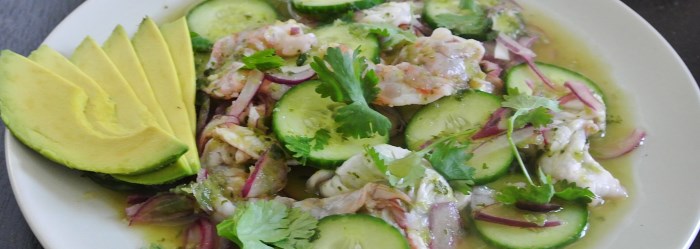
Aguachile, or more correctly Camarones en Aguachile, is a typical dish in the port town of Mazatlán, Sinaloa, Mexico. The dish has roots in the coastal community of Mazatlán and, like other forms of ceviche, is reliant on extremely fresh seafood and plenty of powerful seasoning. The basis for aguachile is found in its name: "Agua," water, and "chilies," chili peppers. Thus the basic ingredients of the marinade are hot peppers, water, lime juice and salt. Sliced cucumbers and julienned red onions are also necessary ingredients for a classic aguachile. The cucumbers serve as a cooling agent (since aguachile is supposed to be a fiery ceviche) and the onion can help balance the chili's sharp edge and the shrimp's natural brine.
Aguachile's birthplace, the northern state of Sinaloa, occupies a special place within the context of Mexico's history and economy, especially with regards to food production and cuisine. Sinaloa is known as the "breadbasket of Mexico" due to the scope and magnitude of its agricultural production. The state is one of Mexico's leaders in the production of staples such as rice, beans, wheat and vegetables, and the fishing and livestock industries are a thriving part of the economy. The geography of Sinaloa, with rivers running from the Sierra Madre Occidental range in the east to the Gulf of California in the west, contributes to the state's ability to produce a wide variety of goods. The diverse ecosystems of Sinaloa provide land than can support various types of agriculture, pastures and maritime industries. With this myriad of products available, it's no wonder that Sinaloa has produced some of the iconic dishes of northern Mexico, aguachile among them.
According to lore, before aguachile was made with shrimp, and before lime had a place in the marinade, the pulverized pepper-water mixture was used to rehydrate another (and equally magical) specialty of Sinaloa: machaca. The machaca of Sinaloa is a spiced and smoked dried beef jerky originally created to preserve precious protein. The pepper water was used to rehydrate the meat (and still impart flavor). When and why the transition from machaca to camarones (seafood) happened is anyone's guess, but presumably the introduction of lime juice occurred around the same time.
Another important element of aguachile is the type of pepper used. The most common peppers used in aguachile verde are, expectedly, jalapeño peppers and Serrano peppers, these varieties being extremely prevalent and easy to find. It is sometimes claimed that hotter peppers, like the chiltepe or pequin peppers, are more traditional, but as there are as many recipes as there are cooks, the possibilities are all but endless. Habañero, chile de arbol, chilie poblano, chilie guajillo and others have all appeared in recipes for aguachile. The considerations for the types of pepper used are the heat and the color. Using a dried chili will impart a smoky character and a red color, whereas using a young fresh chili will yield a bright vegetal, or fruity, quality and vibrant green color. Truly the consideration when selecting chilies is three fold: flavor profile, color and heat level.
Many modern examples of aguachile have expanded on the traditional blend of water, lime and chili by including flavoring components such as soy sauce or "seasoning" sauce (e.g. Maggi). The introduction of soy sauce as an ingredient in some aguachile represents the ever-growing pantry of cooks. Perhaps this is another stage in the development of this particular dish, not unlike the switch from machaca to camarones! On occasion, recipes have even completely done away with the "agua" of the dish, replacing it with more lime. Other variations include the addition of garlic, cilantro, oil, onion, hot sauce (typically a Mexican hot sauce) and other herbs such as mint and parsley.
Unlike the vast majority of ceviche, aguachile is not traditionally left in the marinade to cure. This particular dish, rather than cooking in the acidulated marinade, is classically eaten while the shrimp are still raw. This is, of course, not a hard and fast rule. Eating shrimp raw requires getting sushi grade, untreated product, which is nearly impossible to find. And the alternative, allowing the shrimp to "cook" in the lime juice, still yields a perfectly velvety texture and makes delicious snack.
Aguachile at first glance is a very simple dish, but that belies how difficult achieving balance can be. The few ingredients need to blend harmoniously to achieve the sublime balance of spicy, acidic, savory and sweet. It takes a steady hand and focus (not to mention a couple of attempts) to find a balance that works for you. In the end, it's all about the freshness of your ingredients and the balance between components that makes or breaks this dish. So put on some Pedro Infante (another great export from Mazatlan, Sinaloa), get some tostadas, avocados and maybe a michelada or two, and enjoy this classic of Mexico's western coast.
The recipe below is a variant on a classic Mazatlan style aguachile. I encourage you to play around with the amount of spice, lime and other ingredients in order to make this dish your own. For this recipe you will need a mortar and pestle (or molcajete), or a blender and a nonreactive bowl (preferably glass).
Ingredients:
- 1 pound large brown Shrimp, peeled and deveined
- 4-5 serrano peppers, minced
- 1 clove garlic, peeled
- ¼ cup cilantro, washed and chopped
- 2-3 tablespoons water
- 5-6 tablespoons lime juice
- ½ red onion, julienned
- 2 Persian cucumbers, halved and sliced, or 1 English cucumber, halved, seeded and sliced.
- Salt and pepper, to taste
- Avocado and tostadas, to serve
Preparation:
- Carefully split the shrimp in half lengthwise, discarding any residual veins in the process.
- Lay the shrimp halves onto a plate or baking sheet, ensuring there is no overlap.
- Salt the individual pieces of shrimp generously. This will cure the shrimp and begin the cooking process. Cover and place in the refrigerator for 1-2 hours.
- Using a large mortar and pestle (or a molcajete) pulverize the serranos into a paste, adding a bit of salt to act as an abrasive.
- Next, work in the clove of garlic, cilantro and two or three tablespoons of water until a smooth paste forms. Add the next ingredient only after the previous has been fully incorporated.
- Incorporate the lime juice, tasting for salt, acidity and heat, adjusting as necessary. The mixture should be loose and liquefied, with an aggressive heat and pronounced lime flavor.
- Remove the shrimp from the fridge and place into a large, nonreactive mixing bowl. Add the julienned red onions and the chili/lime marinade.
- Cover the bowl in plastic wrap and return for the fridge for 45 minutes to one hour.
- Allow the shrimp to "cook" in the marinade. The shrimp are ready when the flesh is completely white but tender and no signs of grey are present. The outer section of the shrimp (the sections formerly covered by shell) will be a light shade of pink.
- Peel the skin from the cucumber (if using an English or hot house variety) and cut in half. Remove the seeds using a small spoon, leaving the firm flesh intact. Then slice into ½ inch rounds and add to the shrimp.
- Season the mixture with salt and pepper to taste and serve with sliced avocado and tostadas.
*Note: Instead of using a mortar and pestle, add the chilies, garlic, cilantro, water and lime juice to a blender and blend until smooth. Season the mixture with salt and pepper once fully blended.
Michelada Ingredients:
- 2-3 dashes maggi
- 1 dashes soy sauce
- 5 dashes Tabasco (or other Mexican hot sauce)
- ¼ lime, juiced
- 1/8th teaspoon sugar
- 4 ounce Clamato
- Ice cubes (4 cubes)
- Mexican lager beer (i.e. Modelo, Bohemia, Pacifico, etc)
Michelada Preparation:
- Lightly cover a plate with Tajin, or similar spice mixture.
- Rim a pint glass with the juice of a lime wedge by running the wedge along the lip of the glass. Place the lip onto the Tajin-covered plate to coat the rim.
- Add soy sauce, maggi seasoning, Tabasco, sugar and lime juice to the bottom of a pint glass.
- Add clamato and stir.
- Top mixture with ice cubes and fill the glass with a light beer of your choice. I highly recommend Negra Modelo.
Recipe and photo by Liam Fox








